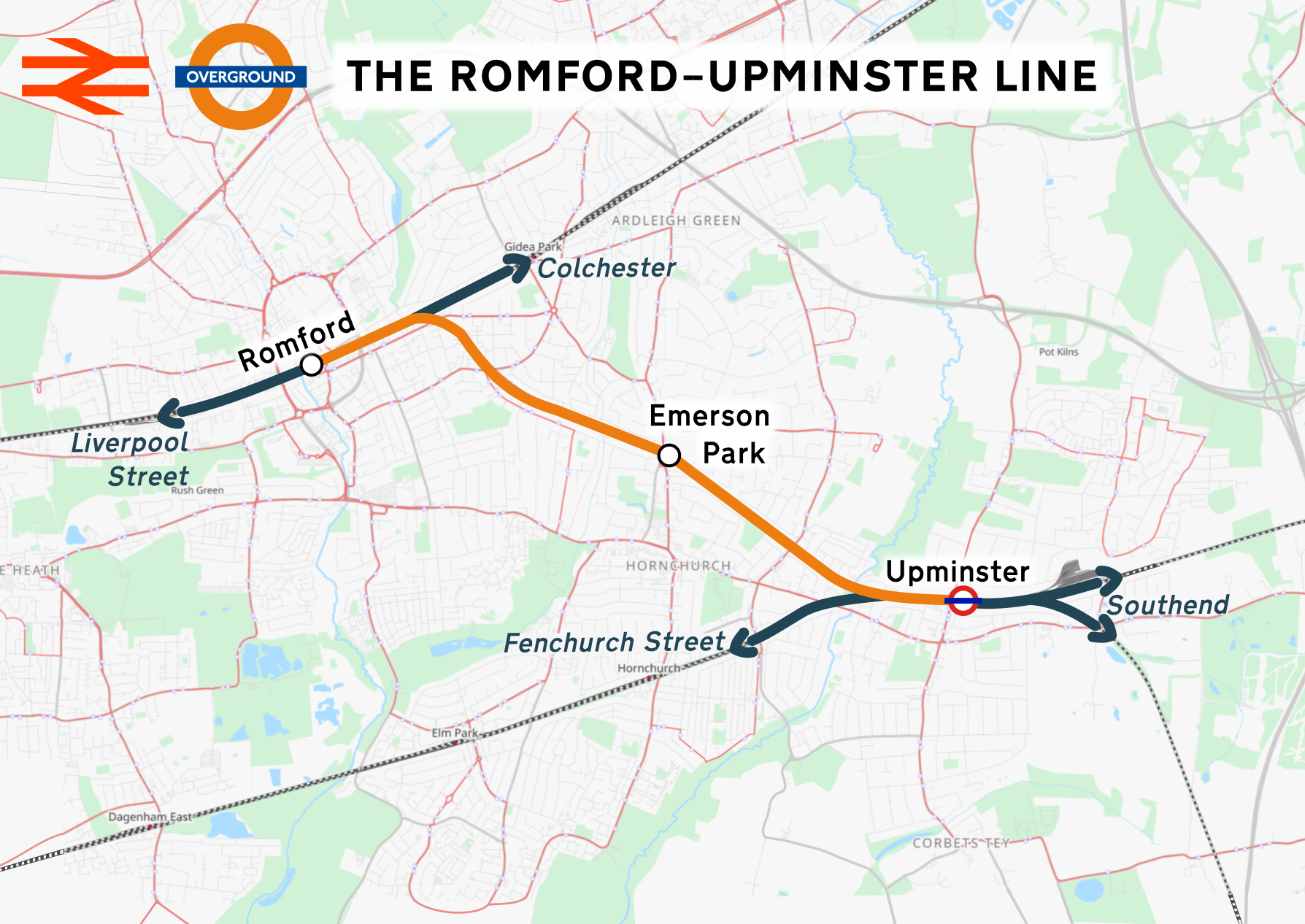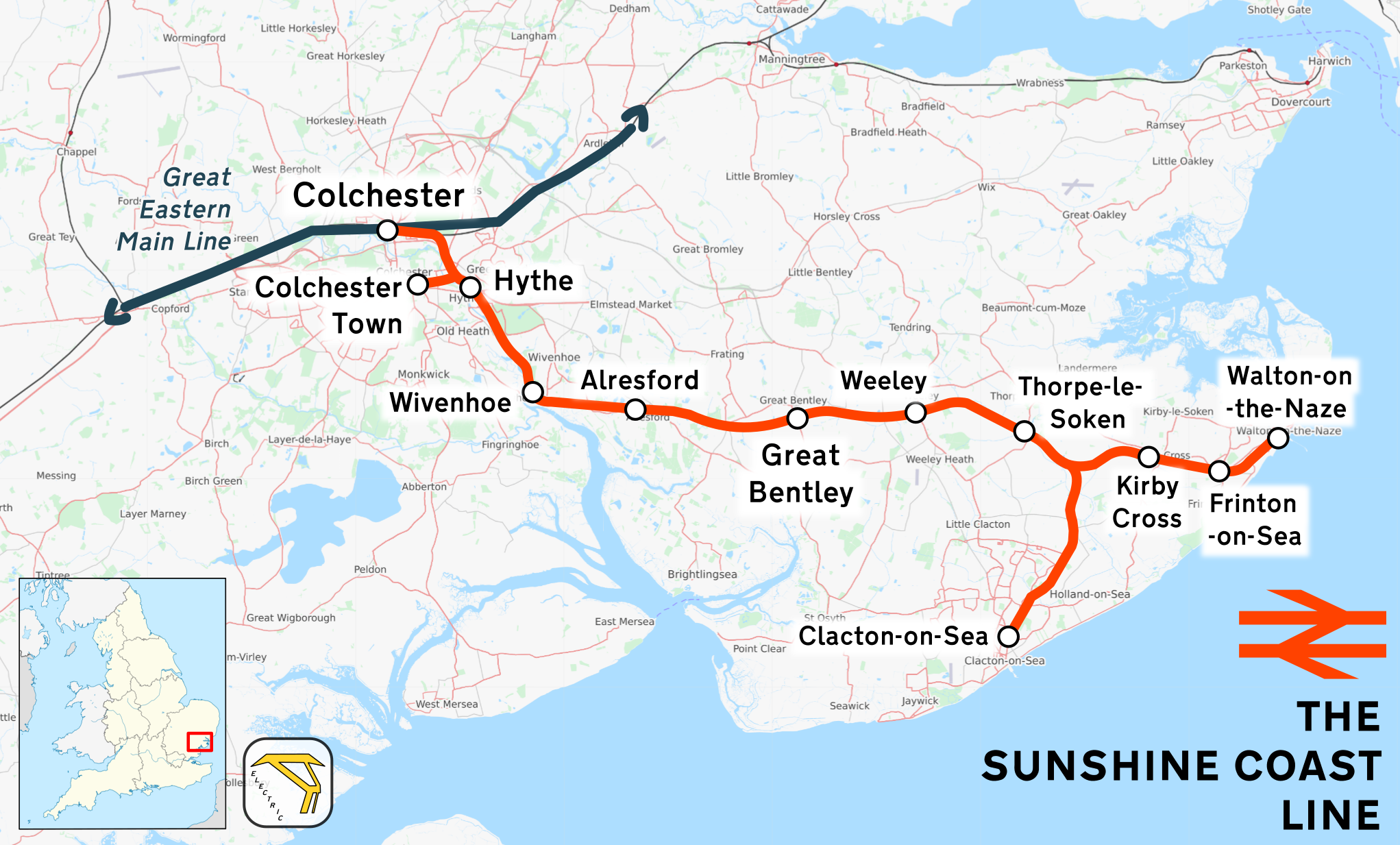|
Network Rail Route 7 (Great Eastern)
Strategic Route 7 - Great Eastern was the designation given by Network Rail, from 2004 to 2009, to a grouping of railway lines in the East of England that encompassed the Great Eastern Main Line and its various branch lines. The route serviced the regional centres of Colchester, Ipswich and Norwich as well as the ports of Felixstowe and Harwich. In 2010, Network Rail restructured its route categorisation. Routes 5 and 7 were merged into Strategic Route D: East Anglia. Strategic route sections The Route was divided into a number of separate Strategic Route Sections (SRS's) that were defined based on route use, infrastructure and historical lines. Railway planning As part of Network Rail's Strategic Business Plan a Route Plan for each route, including Route 7, was published annually. The Route 7 plans for 2008 and 2009 are made available online. Together with Route 5 – West Anglia and Route 6 – North London Line and Thameside the route was included in the Greater An ... [...More Info...] [...Related Items...] OR: [Wikipedia] [Google] [Baidu] |
Network Rail
Network Rail Limited is the owner (via its subsidiary Network Rail Infrastructure Limited, which was known as Railtrack plc before 2002) and infrastructure manager of most of the railway network in Great Britain. Network Rail is an "arm's length" public body of the Department for Transport with no shareholders, which reinvests its income in the railways. Network Rail's main customers are the private train operating companies (TOCs), responsible for passenger transport, and freight operating companies (FOCs), who provide train services on the infrastructure that the company owns and maintains. Since 1 September 2014, Network Rail has been classified as a "public sector body". To cope with fast-increasing passenger numbers, () Network Rail has been undertaking a £38 billion programme of upgrades to the network, including Crossrail, electrification of lines and upgrading Thameslink. In May 2021, the Government announced its intent to replace Network Rail in 2023 with a ne ... [...More Info...] [...Related Items...] OR: [Wikipedia] [Google] [Baidu] |
Romford–Upminster Line
The Romford–Upminster line is a railway branch line in Greater London that connects , on the Great Eastern Main Line, to , on the London, Tilbury and Southend line and London Underground. The route is in length and there is one intermediate station at . The line is part of Network Rail Strategic Route 7, SRS 07.09, and is classified as a rural line. The line is single-track throughout, electrified at 25 kV AC, has a loading gauge of W6, and a maximum speed of . , services are operated by London Overground, with two trains per hour in each direction. The timetabled journey time from one terminus to the other is nine minutes. It is completely separated from the rest of the London Overground, but connects to the Elizabeth line at Romford and the London Underground at Upminster. History Steam era The line was originally built as a branch of the London, Tilbury and Southend Railway (LT&SR) and opened on 7 June 1893 providing the LT&SR with a link to the Great Eastern Railwa ... [...More Info...] [...Related Items...] OR: [Wikipedia] [Google] [Baidu] |
Stratford, London
Stratford is a town in east London, England, within the ceremonial county of Greater London. Until 1965 it was within the historic county of Essex. Part of the Lower Lea Valley, Stratford is situated 6 miles (10 km) east-northeast of Charing Cross, and includes the localities of Maryland and East Village. Part of the London Borough of Newham, a local government district of Greater London, it was previously part of the parish of West Ham, which historically formed an ancient parish in the hundred of Becontree. Following reform of local government in London in 1965, the parish and borough of West Ham was abolished, becoming part of the borough of Newham in the newly formed Greater London administrative area and ceremonial county. Stratford grew rapidly in the 19th century following the introduction of the railway to the area in 1839, forming part of the conurbation of London, similar to much of south-west Essex. The late 20th century was a period of severe economic decl ... [...More Info...] [...Related Items...] OR: [Wikipedia] [Google] [Baidu] |
Greater Anglia Route Utilisation Strategy
The Greater Anglia Route Utilisation Strategy is a Route Utilisation Strategy published by Network Rail in December 2007. It was the sixth RUS to be produced. The area covered includes the whole of Route 5 West Anglia (WA) and Route 7 Great Eastern (GE), which both focus for passenger purposes on London Liverpool Street, and the London Fenchurch Street services from Route 6. As with other RUSs, the Greater Anglia RUS took into account a number of responses, including the Office of Rail Regulation (ORR). The routes and services covered by the RUS are varied in type. The key issues are peak crowding on inner suburban, outer suburban and some long-distance services, and the capacity of the routes to handle growing container freight traffic; however off-peak service gaps on main passenger routes are dealt with, and the routes also include a number of relatively lightly used services, though with some peak 'spikes'. Like other strategies in this series, recommendations are divide ... [...More Info...] [...Related Items...] OR: [Wikipedia] [Google] [Baidu] |
Network Rail Route 6 (North London Line And Thameside)
Strategic Route 6 - North London Line and Thameside was the designation Network Rail gave to a grouping of railway lines in Greater London and the East of England region that encompassed the London, Tilbury and Southend Line and overground commuter lines within London. The route provided key services to Southend and London suburban areas as well as supporting various freight routes within London. In 2010, Network Rail restructured its route categorisation. Route 6 was split into Strategic Route E: North London Line, and Strategic Route F: Thameside. Strategic route sections The Route was divided into a number of separate Strategic Route Sections (SRS's) that were defined based on route use, infrastructure and historical lines. Railway planning As part of its Strategic Business Plan, Network Rail annually published a Route Plan for each route, including Route 6; the 2008 and 2009 Route 6 plans are available online. Together with Route 7 - Great Eastern and Route 5 - Wes ... [...More Info...] [...Related Items...] OR: [Wikipedia] [Google] [Baidu] |
Network Rail Route 5 (West Anglia)
Strategic Route 5 - West Anglia was the designation given by Network Rail, from 2004 to 2009, to a grouping of railway lines in the East of England that encompassed the West Anglia Main Line and its various branch lines. The route provided key services to Cambridge and Stansted Airport as well as supporting suburban services in North London and rural services in Cambridgeshire, Norfolk and Suffolk. In 2010, Network Rail restructured its route categorisation. Routes 5 and 7 were merged into Strategic Route D: East Anglia. Strategic route sections The Route was divided into a number of separate Strategic Route Sections (SRS's) that were defined based on route use, infrastructure and historical lines. Railway planning As part of Network Rail's Strategic Business Plan a Route Plan for each route, including Route 5, was published annually. The Route 5 plans for 2008 and 2009 are made available online. Together with Route 7 - Great Eastern and Route 6 - North London Line and ... [...More Info...] [...Related Items...] OR: [Wikipedia] [Google] [Baidu] |
Wherry Lines
The Wherry Lines are railway branch lines in the East of England, linking to and . There are 14 stations including the three termini. They form part of Network Rail Strategic Route 7, SRS 07.11 and are classified as a rural line. The lines pass through the Broads of Norfolk and Suffolk. The name is taken from the Norfolk wherries, which played an important role in the transport of goods and people around the Broads before road and rail transport became widespread. Passenger services on the Wherry Lines are currently operated by Abellio Greater Anglia. History The route was opened from Norwich to Great Yarmouth by the Norwich and Yarmouth Railway in 1844, running via . The line from Reedham to Lowestoft was added in 1847 by Samuel Morton Peto as part of the Norfolk Railway. Finally, the northern route from Norwich to Great Yarmouth via was added in 1883 by the Great Eastern Railway, opening from Breydon Junction to Acle on 12 March, and through to Brundall on 1 June. Co ... [...More Info...] [...Related Items...] OR: [Wikipedia] [Google] [Baidu] |
Bittern Line
The Bittern Line is a railway branch line in Norfolk, England, that links to . It passes through the Broads on its route to an Area of Outstanding Natural Beauty on the north Norfolk coast. It is named after the bittern, a rare bird found in the reedy wetlands of Norfolk. The line is in length and there are 10 stations. It is part of Network Rail Strategic Route 7, SRS 07.11, and is classified as a rural line. Passenger services are operated by Greater Anglia, which also manages all of the stations. History The line was granted permission in 1864 and the first stretch was opened between Norwich and in 1874 by the East Norfolk Railway. It was extended to Cromer by 1877 before being extended to in 1877, using a section of the Midland and Great Northern Joint Railway line. From the early twentieth century until the end of steam services, in 1962, the Great Eastern Railway operated coastal holiday services from London Liverpool Street under names such as the '' Norfolk Coast ... [...More Info...] [...Related Items...] OR: [Wikipedia] [Google] [Baidu] |
Gainsborough Line
The Gainsborough line is the current marketing name of the Sudbury branch line, a railway branch line off the Great Eastern Main Line in the east of England, that links in Essex with in Suffolk. It is in length and single-track throughout. The line's Engineer's Line Reference is SUD. Prior to the Beeching cuts initiated in the 1960s, the line, then known as the Stour Valley Railway, continued beyond Sudbury to in Cambridgeshire. Today the line is part of the Network Rail Strategic Route 7, SRS 07.10, and is classified as a rural line. As of December 2016 the stations and all trains serving them are operated by Greater Anglia. The typical service frequency is one train per hour in each direction, with a timetabled journey time between one terminus and the other of 19 minutes. History The Stour Valley Railway opened on 9 August 1865, linking near Cambridge with in Essex, with 13 intermediate stations along the line. The section between Shelford and was closed on ... [...More Info...] [...Related Items...] OR: [Wikipedia] [Google] [Baidu] |
Sunshine Coast Line
The Sunshine Coast Line is the current marketing name of what originally was the Tendring Hundred Railway Line, a branch off the Great Eastern Main Line in the East of England. It links to the seaside resorts of and, via a branch, . The line is part of the Network Rail Strategic Route 7, SRS 07.08, and is classified as a London & South East commuter line. Passenger services on the line are currently operated by Greater Anglia. Trains for Clacton-on-Sea usually originate at London Liverpool Street, while those for Walton-on-the-Naze typically start at Colchester (or on Sundays). There are, however, limited morning and evening peak-time services in each direction between Walton-on-the-Naze and Liverpool Street. History Steam era The Great Eastern Main Line out of Shoreditch in London reached by 1843 and was extended to in 1846. The first short section of this branch line was built by the Colchester, Stour Valley, Sudbury & Halstead Railway to the port of , and ope ... [...More Info...] [...Related Items...] OR: [Wikipedia] [Google] [Baidu] |


_p18b_-_Bow_Bridge.jpg)


